ASUS F2A85-V Pro Review: A Look at FM2 with A85X
by Ian Cutress on October 10, 2012 11:20 AM EST- Posted in
- Motherboards
- Asus
- Trinity
- FM2
- A85X
USB Speed
For this benchmark, we run CrystalDiskMark to determine the ideal sequential read and write speeds for the USB port using our 240 GB OCZ Vertex3 SSD with a SATA 6 Gbps to USB 3.0 converter. Then we transfer a set size of files from the SSD to the USB drive using DiskBench, which monitors the time taken to transfer. The files transferred are a 1.52 GB set of 2867 files across 320 folders – 95% of these files are small typical website files, and the rest (90% of the size) are the videos used in the Sorenson Squeeze test.
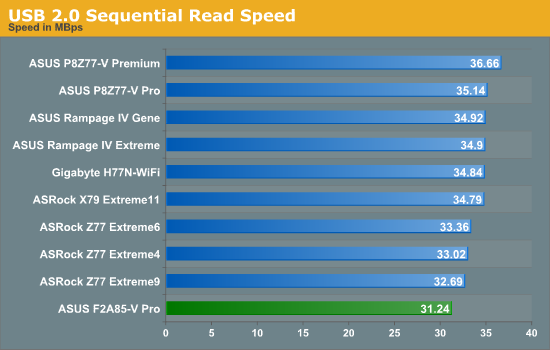
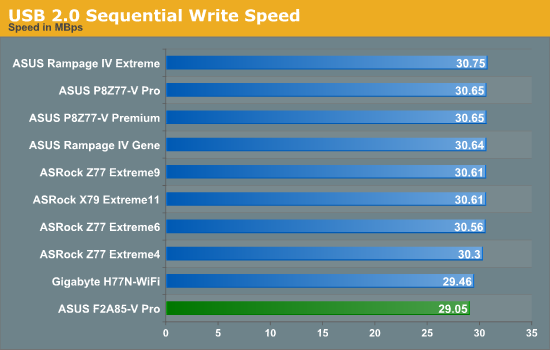
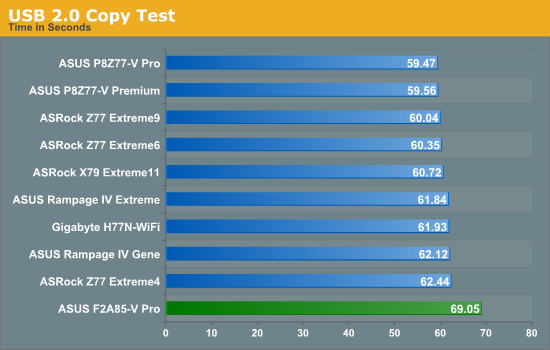
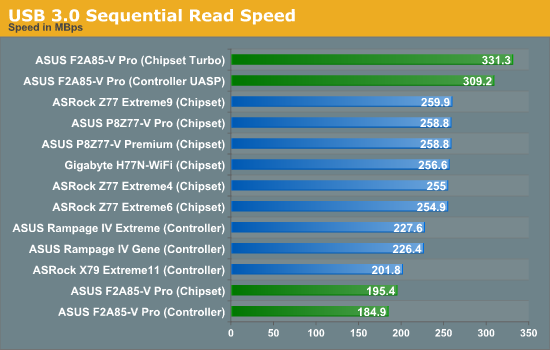


For whatever reason, our standard USB testing regimen on AMD systems shows a slight speed deficiency compared to the Intel systems. In USB 3.0 our copy tests are more than 10% slower on an AMD system.
SATA Testing
We also use CrystalDiskMark for SATA port testing on a C300 drive. The sequential test (incompressible data) is run at the 5 x 1000 MB level. This test probes the efficiency of the data delivery system between the chipset and the drive, or in the case of additional SATA ports provided by a third party controller, the efficiency between the controller, the chipset and the drive.

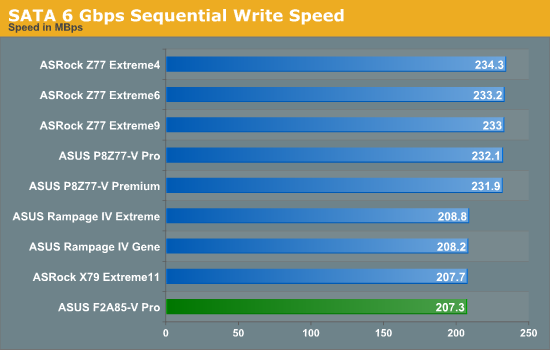
I really like the fact that the AMD chipset is SATA 6 Gbps only, although we see that SATA peak write speeds on this board are slightly lower than that of most Intel boards. Previously this is normally attributed to BIOS settings at default.
DPC Latency
Deferred Procedure Call latency is a way in which Windows handles interrupt servicing. In order to wait for a processor to acknowledge the request, the system will queue all interrupt requests by priority. Critical interrupts will be handled as soon as possible, whereas lesser priority requests, such as audio, will be further down the line. So if the audio device requires data, it will have to wait until the request is processed before the buffer is filled. If the device drivers of higher priority components in a system are poorly implemented, this can cause delays in request scheduling and process time, resulting in an empty audio buffer – this leads to characteristic audible pauses, pops and clicks. Having a bigger buffer and correctly implemented system drivers obviously helps in this regard. The DPC latency checker measures how much time is processing DPCs from driver invocation – the lower the value will result in better audio transfer at smaller buffer sizes. Results are measured in microseconds and taken as the peak latency while cycling through a series of short HD videos - under 500 microseconds usually gets the green light, but the lower the better.
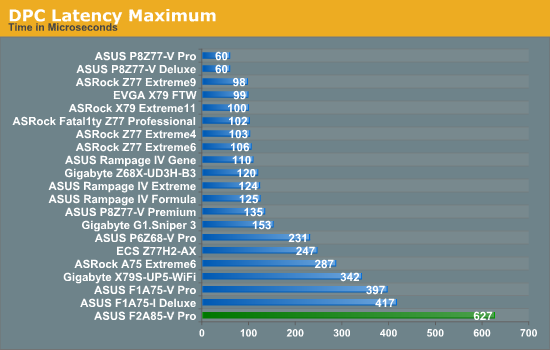
Normally our DPC Latency tests can be affected by monitoring software, producing a value north of 1000 microseconds. Anything under 500 is acceptable, and under 200 is great. However the F2A85-V Pro gets a value in the 600s. During the test, the DPC would hover between 100 and 200 most of the time, but every now and again would peak in the 600 region for whatever reason. The system was rebooted a couple of times but this behavior was persistent across boots. As of the 5104 BIOS this would be slightly worrying for audio work.










66 Comments
View All Comments
zappb - Sunday, November 4, 2012 - link
I just build 3 of these office machines (prices in euros before VAT / sales tax)AMD A6-5400K - 50
Asrock FM2A75M - DGS - 45
Fractal Core 1000 - 30
Intel 330 120 GB ssd - 75
Mushkin 4GB ddr3 -1600- 13
Be quiet pure power L7 300w - 32
Win8 pro oem (w/Start8)a 110
Office 2010 pro 100
Hardware comes to €245, and if I could have sourced the A4-5300, would have knocked another 15 off that. Amd will be pricing the entry level FM2 stuff really agressively in Jan 2013 onwards, so you could probably pick up the A4-5300 for 30 euro.
,
WEI scores are: Processor: 6.3, Memory: 5.9, Graphics: 4.7, Gaming Graphics: 6.3, primary hard disk, 8.1.
Will test power consumption shortly, but just seeing the load on the CPU with excel, word, and chrome with 5 browser windows open, it hovers around 1- 4%, so meaning for these light usage cases, it might be cheaper to run than the intel options (that would be a real turn up for the books).
crimson117 - Wednesday, October 10, 2012 - link
I'm having trouble parsing this sentence...> From my perspective, a storage system the RAID 5 that the A85X chipset supports across the eight SATA 6 Gbps ports is golden where Trinity is concerned.
KineticHummus - Thursday, October 11, 2012 - link
it means using trinity in a storage system/home server is great because it natively supports raid 5 across all 8 sata3 ports, which intel can not do.Anonymous Blowhard - Thursday, October 11, 2012 - link
Except that anyone running an 8-drive RAID5 with large, slow, consumer off the shelf SATA drives is either uninformed or a moron.Odds on getting an unrecoverable read error with large (1TB+) drives during a RAID5 rebuild are incredibly high; that's why enterprise SANs are using things like 450GB/600GB SAS drives now, and those have a failure rate an order of magnitude lower than consumer grade SATA.
Home servers should be using RAID1, 10, Z, Z2 - or just none at all. Whatever you use, doing proper backups (which RAID is not) is critical if you care about your data. DVDs I've ripped? I can get those again. Pictures of my son's first birthday? Backed up in triplicate, multiple offsite, and cloud stored.
http://www.zdnet.com/blog/storage/why-raid-5-stops...
ven1ger - Thursday, October 11, 2012 - link
First of if you're calling someone a moron, maybe you should look in the mirror.The article that you linked was written back in 2007, and if you read some of the comments, many of the comments thought it was much ado about nothing.
Maybe you should check out what current cloud based backup companies look like, here's an example that I was just reading about a couple of days ago.
http://blog.backblaze.com/
Very interesting story, commercial cloud based storage company that uses consumer SATA drives. They even have open-sourced hardware design(s) available for their PODs that anyone can use to create their own muti-drive backup system, and which several others have created, if you are so inclined that way.
I am no way involved with Backblaze, just was an interesting story piece that I ran across and their tale of harvesting consumer grade 3TB SATA drives in the aftermath of the Thailand flooding.
Anonymous Blowhard - Thursday, October 11, 2012 - link
Ad hominem ignored.The article was correct then and even more now. As data density has increased, reliability has not kept pace.
Using BackBlaze, or most any "cloud backup provider" as a reference for pro-RAID-5 is a bad idea. Cloud storage providers create their redundancy at the system level. Reliability, availability, and operational efficiencies are all hugely increased by treating the entire system as an FRU. It's cheaper for them to just wait for there to be enough downed pods to justify "Okay, let's roll into the DC, pull out a dozen systems, and slap in new ones." They don't have the time or concern to troubleshoot individual drive failures.
(Also, BackBlaze uses RAID-6.)
So again, if you're using RAID-5 with big, slow, error-prone drives; please stop doing that if you care about your data.
Memristor - Wednesday, October 10, 2012 - link
What version of the AHCI, RAID and USB 3.0 BIOS is on this new board? It would be very helpful if you could include the version of these BIOS's in your board reviews. Since it is very easy to updated the firmware of these components outside of a regular motherboard BIOS update it can be very helpful to increase performance and other issues that arise especially with RAID configurations and newer SSD drives.djshortsleeve - Wednesday, October 10, 2012 - link
Ian, glad you mentioned hysteresis. I dont understand why they dont incorporate this control? Its fairly simple as long as a target temperature is defined.goinginstyle - Wednesday, October 10, 2012 - link
"This could be an error on the part of OCCT.." If you do not know what the problem is then why mention it in the review as a performance concern. Either OCCT is updated to work with Trinity or more than likely it is not but find out before you state it. As to DPC latency, is it really a EFI problem or a platform problem as Llano is not much better.Hardcore69 - Wednesday, October 10, 2012 - link
Why bother? An Ivy Bridge i3 is 55w and is close to the equivalent except for the GPU, less than a fart's difference CPU wise. Compared to a hot 100w CPU, if you don't game, this isn't worth bothering with. At all for a standard office box. As for the mobo, I'd prefer a gruntier CPU than fancy useless heatpipes.